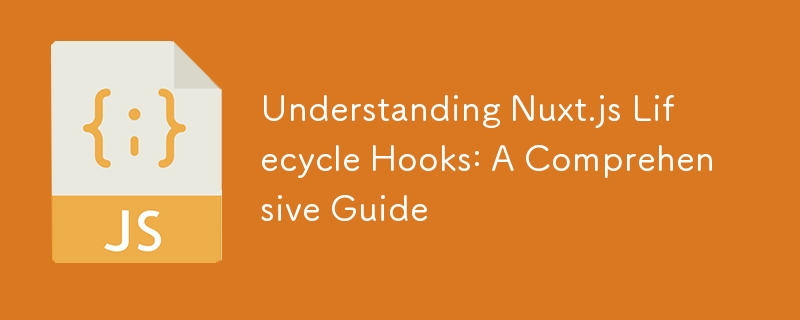了解 Nuxt.js 生命周期挂钩:综合指南

When building a Nuxt.js application, understanding its lifecycle hooks is crucial for fine-tuning performance and controlling when certain actions occur. This post will break down each lifecycle hook, giving you a solid understanding of how and when to use them effectively.
What Are Lifecycle Hooks?
Lifecycle hooks in Nuxt.js allow developers to execute code at specific stages of an application's initialization, rendering, and destruction processes. These hooks can be used to manage asynchronous data fetching, handle side effects, or trigger transitions, among other tasks.
Key Lifecycle Hooks in Nuxt.js
- asyncData
- When it’s called: Before the component is initialized on both the server and client.
- What it’s used for: It allows you to fetch data asynchronously and inject it into your component. This hook doesn't have access to this, but you can return an object that will be merged with the component's data.
export default {
async asyncData({ params }) {
const data = await fetchData(params.id)
return { data }
}
}
2. fetch
- When it’s called: Only during server-side rendering and before the component is created.
- What it’s used for: Unlike asyncData, this hook has access to this, so you can fetch data and assign it directly to component properties.
export default {
async fetch() {
this.data = await fetchData(this.$route.params.id)
}
}
3. created
- When it’s called: After the component instance has been created (on both the client and server).
- What it’s used for: It’s a good place to initialize component state or trigger actions that don’t rely on DOM rendering.
export default {
created() {
console.log('Component is created!')
}
}
4. mounted
- When it’s called: After the component is mounted to the DOM, but only on the client side.
- What it’s used for: This is the perfect hook for DOM-related operations, like initializing third-party libraries that depend on the presence of HTML elements.
export default {
mounted() {
console.log('Component is mounted to the DOM!')
}
}
5. beforeDestroy
- When it’s called: Right before the component is destroyed (on both the client and server).
- What it’s used for: You can use this hook to perform any cleanup operations, such as removing event listeners.
export default {
beforeDestroy() {
console.log('Cleaning up resources...')
}
}
6. nuxtServerInit
- When it’s called: This is a special action in the Vuex store, triggered before server-side rendering.
- What it’s used for: It allows you to populate the store with data available before the application is rendered on the server.
export const actions = {
async nuxtServerInit({ commit }) {
const data = await fetchInitialData()
commit('setData', data)
}
}
Summary of Lifecycle Hooks
- Server-side only: asyncData, fetch, nuxtServerInit
- Client-side only: mounted
- Both client and server: created, beforeDestroy
Conclusion
Nuxt.js lifecycle hooks are powerful tools for controlling your app’s behavior at different stages of the rendering process. Understanding when and how to use them will help you improve the performance and user experience of your application.
以上是了解 Nuxt.js 生命周期挂钩:综合指南的详细内容。更多信息请关注PHP中文网其他相关文章!

热AI工具

Undresser.AI Undress
人工智能驱动的应用程序,用于创建逼真的裸体照片

AI Clothes Remover
用于从照片中去除衣服的在线人工智能工具。

Undress AI Tool
免费脱衣服图片

Clothoff.io
AI脱衣机

Video Face Swap
使用我们完全免费的人工智能换脸工具轻松在任何视频中换脸!

热门文章

热工具

记事本++7.3.1
好用且免费的代码编辑器

SublimeText3汉化版
中文版,非常好用

禅工作室 13.0.1
功能强大的PHP集成开发环境

Dreamweaver CS6
视觉化网页开发工具

SublimeText3 Mac版
神级代码编辑软件(SublimeText3)
 神秘的JavaScript:它的作用以及为什么重要
Apr 09, 2025 am 12:07 AM
神秘的JavaScript:它的作用以及为什么重要
Apr 09, 2025 am 12:07 AM
JavaScript是现代Web开发的基石,它的主要功能包括事件驱动编程、动态内容生成和异步编程。1)事件驱动编程允许网页根据用户操作动态变化。2)动态内容生成使得页面内容可以根据条件调整。3)异步编程确保用户界面不被阻塞。JavaScript广泛应用于网页交互、单页面应用和服务器端开发,极大地提升了用户体验和跨平台开发的灵活性。
 JavaScript的演变:当前的趋势和未来前景
Apr 10, 2025 am 09:33 AM
JavaScript的演变:当前的趋势和未来前景
Apr 10, 2025 am 09:33 AM
JavaScript的最新趋势包括TypeScript的崛起、现代框架和库的流行以及WebAssembly的应用。未来前景涵盖更强大的类型系统、服务器端JavaScript的发展、人工智能和机器学习的扩展以及物联网和边缘计算的潜力。
 JavaScript引擎:比较实施
Apr 13, 2025 am 12:05 AM
JavaScript引擎:比较实施
Apr 13, 2025 am 12:05 AM
不同JavaScript引擎在解析和执行JavaScript代码时,效果会有所不同,因为每个引擎的实现原理和优化策略各有差异。1.词法分析:将源码转换为词法单元。2.语法分析:生成抽象语法树。3.优化和编译:通过JIT编译器生成机器码。4.执行:运行机器码。V8引擎通过即时编译和隐藏类优化,SpiderMonkey使用类型推断系统,导致在相同代码上的性能表现不同。
 JavaScript:探索网络语言的多功能性
Apr 11, 2025 am 12:01 AM
JavaScript:探索网络语言的多功能性
Apr 11, 2025 am 12:01 AM
JavaScript是现代Web开发的核心语言,因其多样性和灵活性而广泛应用。1)前端开发:通过DOM操作和现代框架(如React、Vue.js、Angular)构建动态网页和单页面应用。2)服务器端开发:Node.js利用非阻塞I/O模型处理高并发和实时应用。3)移动和桌面应用开发:通过ReactNative和Electron实现跨平台开发,提高开发效率。
 Python vs. JavaScript:学习曲线和易用性
Apr 16, 2025 am 12:12 AM
Python vs. JavaScript:学习曲线和易用性
Apr 16, 2025 am 12:12 AM
Python更适合初学者,学习曲线平缓,语法简洁;JavaScript适合前端开发,学习曲线较陡,语法灵活。1.Python语法直观,适用于数据科学和后端开发。2.JavaScript灵活,广泛用于前端和服务器端编程。
 如何使用Next.js(前端集成)构建多租户SaaS应用程序
Apr 11, 2025 am 08:22 AM
如何使用Next.js(前端集成)构建多租户SaaS应用程序
Apr 11, 2025 am 08:22 AM
本文展示了与许可证确保的后端的前端集成,并使用Next.js构建功能性Edtech SaaS应用程序。 前端获取用户权限以控制UI的可见性并确保API要求遵守角色库
 从C/C到JavaScript:所有工作方式
Apr 14, 2025 am 12:05 AM
从C/C到JavaScript:所有工作方式
Apr 14, 2025 am 12:05 AM
从C/C 转向JavaScript需要适应动态类型、垃圾回收和异步编程等特点。1)C/C 是静态类型语言,需手动管理内存,而JavaScript是动态类型,垃圾回收自动处理。2)C/C 需编译成机器码,JavaScript则为解释型语言。3)JavaScript引入闭包、原型链和Promise等概念,增强了灵活性和异步编程能力。
 使用Next.js(后端集成)构建多租户SaaS应用程序
Apr 11, 2025 am 08:23 AM
使用Next.js(后端集成)构建多租户SaaS应用程序
Apr 11, 2025 am 08:23 AM
我使用您的日常技术工具构建了功能性的多租户SaaS应用程序(一个Edtech应用程序),您可以做同样的事情。 首先,什么是多租户SaaS应用程序? 多租户SaaS应用程序可让您从唱歌中为多个客户提供服务






